River Fishing
Species you will be fishing for on the Salmon River: Chinook Salmon, Coho Salmon, Steelhead, Domestic Rainbows, Brown Trout and Atlantic Salmon.
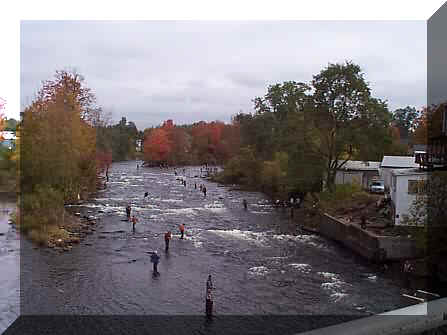
Welcome to home of the world famous Salmon River in NY!
The
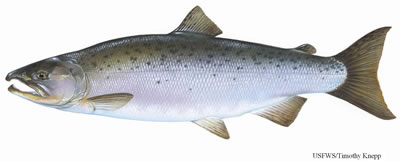
The fish that return to the

Coho Salmon are less in numbers and in size. The record Coho was caught in the lake near
Catching these trophy fish requires the right type of tackle and the right technique. I have learned to match the tackle and technique to the conditions which the River provides us. In other words, I can help you catch trophy fish whether it is early or late in the run, or the river is abnormally high or low. This is when my season begins. I will take clients to the estuary in my drift boat at all hours of the day or night to either fish egg sacks or to troll glow lures at night. This type of fishing can be very productive. It is possible to get your limit in a couple of hours if the fishing is hot. It is easy fishing and you do not need a lot of experience just a bit of patience.
As the season progresses, salmon start to move into the river. At this point, we may drift down the river in the drift boat or float boats stopping at several hot spots until we find good numbers of fish or we will wade fish and hike in on a spot which sometimes can be allot easier that taking the boat. This fishing is very different from estuary fishing. It requires waders, the ability to wade a river, and to put up with sometimes very crowded conditions but we do and can find several good fishing spots that have little to no pressure form other anglers.
Drawbacks aside, this can be the most exciting fishing experience in your life. When conditions are right, you may hook upwards of 30 fish in a day. These fish will wear you out. I have had several battles that took over 30 minutes to win. It is not uncommon for the battle to require you to either walk but mostly run up or down the river in order to land the fish. These are tough fish that test the angler and the tackle. THESE ARE TRULY CALLED TROPHY FISH!
More Salmon River Fishing Info
The Salmon River located in Northern New York State is a tremendous fishery consisting of prolific runs of King and Coho Salmon as well as Steelhead and Brown trout from Lake Ontario. Flowing out of the Salmon River Reservoir, this dynamic river makes a 13 mile journey before emptying into Lake Ontario at Port Ontario. Pulaski is a renowned and popular town due to the Salmon River and its awesome fishery. Depending upon water flows and temperatures, late August is generally the start of the fall run of King Salmon.
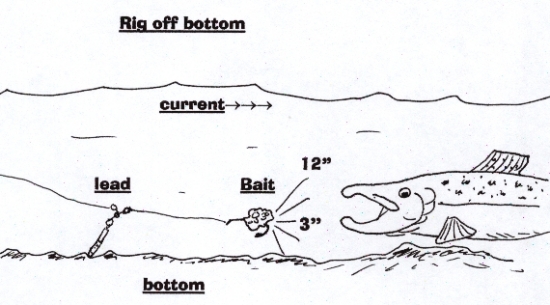
This enormous run of fish lasts till late October when the steelhead start their annual jaunt (water levels and other factors dictate when these fish begin and end their run). The King Salmon (also known as Chinook Salmon) are large, averaging twenty to thirty pounds. Fish to forty plus pounds have been caught. Most of the fishermen during the salmon run use spinning outfits. Unlike Steelhead and Brown Trout the King Salmon do not "take" as well. Although they are in the river to spawn and feeding is their last priority, these fish will strike out of aggression when they are fresh from the lake and have not seen many flies.
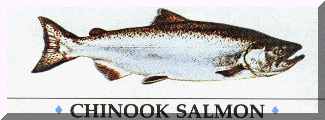
Once the fish have been in for a long period of time they tend to not strike with the same aggression. There has been controversy about fishermen "lifting" salmon. "Lifting" is when they try to snag the fish, which is an unfortunate part of the entire Great Lake's fishery. Snagging has been outlawed and game wardens patrol the river to issue fines to anglers that are caught violating the rules that govern this fishery. Check all the Special Regulations before fishing. If you do not understand the regulations, there are many shops in the area that will explain them.
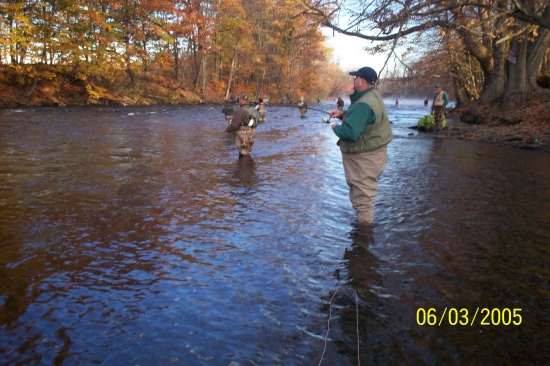
Another factor about the salmon run is the amount of fishermen it draws to the river. It is not uncommon to see anglers shoulder-to-shoulder for a hundred yards in a likely hole. A few popular fly patterns for the salmon are large krystal buggers, egg patterns, and estaz flies all tied on extra strong hooks. Steelhead are what most fly fishermen come to the Salmon River for. The steelhead average eight to ten pounds and fish over twenty pounds have been caught. They can be in the river anytime from late September to May. There are also summer run steelhead called Skamania which are not as dependable but can be in the river during the summer months providing that water conditions allow it. Steelhead are very aggressive, especially from October to late November, because they are in the river to feed with the abundance of salmon eggs available and optimum water temperatures.
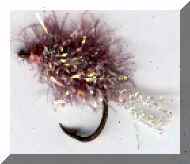
This is also a good time for them, because the weather near the Great Lakes is still tolerable. Estaz flies, egg sucking leeches, woolly buggers, and yarn eggs work best this time of year. Winter Steelhead fishing from December through late February can be very productive and also very cold. Make sure to bring along plenty of warm clothing if you go. Temperatures will drop below zero and lake effect snow squalls can pop up at any time. At this time generic nymphs, small black stone fly nymphs, and small egg patterns work best. Remember that the winter fish tend to be more lethargic because of the extremely cold water temperatures. Fish slow and look for some of the softer seams where they do not have to fight strong currents. March through April is a good time for steelhead as well. Like the fall the weather is generally more tolerable then during the winter months. The fish at this time of year are generally less active then during the fall and are there more to spawn, although they will feed and the fishing can be excellent. Starting around late April and May the steelhead will drop out of the river back to the lake. This is a good time to fish for drop-backs that are extremely aggressive after spawning. They need to feed and will take dries, streamers and wet flies (spey flies) eagerly.
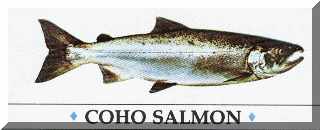
Coho Salmon, also known as Silver Salmon, can be in the river anytime during the fall from September to December. They are more aggressive then the King Salmon and will strike eagerly at a fly (especially the males). Coho's are hard fighting acrobatic fish similar to Steelhead. Most people do not come to the Salmon River specifically for the coho salmon fishing, but come across them while fishing for other species. Brown Trout can also be in the river along with the Steelhead. The best time for browns is usually from late September to early December.

The Brown Trout migrating into the Salmon River from Lake Ontario are very large averaging five to eight pounds and browns to fifteen plus pounds have been caught. Steelhead flies will work effectively on the Brown Trout. The Salmon River is made up of churning pools, deep runs, riffles, glides, and pockets. The river bed is mostly slate and gravel and cleated waders are necessary to keep your footing. Water conditions on this river can change rapidly (within minutes) with the water releases used for generating power. If your not familiar with the water be smart and pay attention to changing conditions. The upper end of the river is made up mostly of deep pools and runs and is generally less swift. Below Route 81 the river picks up speed on its way to Lake Ontario. This area is made up mostly of hard pushing pools, glides, swift runs, and pockets.
The upper end of the Salmon River near Altmar has two fly fishing only sections. Check the special regulations. Fishing in the vicinity of Altmar can be good since the fish tend to hold up well there. This area can also be very crowded so remember that the fish entering the Salmon River are migrating in from the lake and can be anywhere in the river. Below Altmar the river flows through pools such as the Unemployment Hole, the School House Pool, the Upper and Lower Wire Holes, Ellis Cove, Trestle Pool, the Island Hole, Pineville Bridge Pool, The Ace In The Hole, the Sportsman's Pool, the Glass Hole, the Compactor Pool, the Papermill pool, the Ball Field, The Short and Long Bridge Pools and Black Hole as well as many others.
Below the Black Hole the river enters the Douglaston Salmon Run which is an area you need to purchase a permit in order to fish. This area is excellent and offers angling for fish fresh from the lake since it borders the mouth of the river. These fish tend to be less selective and will eagerly take a well presented pattern. Overall there is approximately 12 miles of very productive water to fish. Some areas tend to hold fish better then others but remember that they are migrating fish and have to get through one area in order to get to the next. Access to the river is generally easy.
There are numerous designated access points as well as other areas to pull over and fish. Routes 13, 11, 81, and 2 as well as other roads provide access to the river. Fish an area and move if your not successful. Sometimes its a matter of finding the fish. Other times it may be waiting for the water temperatures to warm enough for them to take. Either way be patient with the fishery. The opportunity is there to hook or catch a good number of large fish. If you put your time in you will most likely be largely rewarded! The Salmon River is New York State is a famous fishery for migratory Salmon, Steelhead, and Brown Trout.
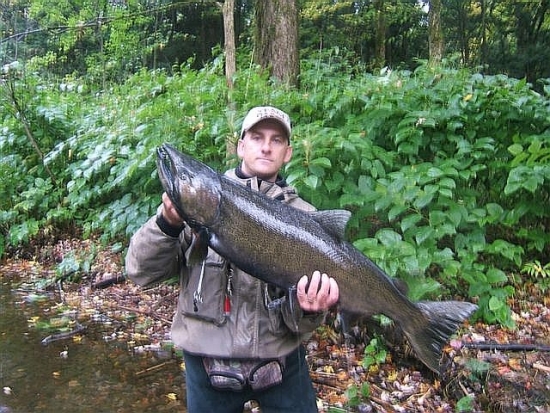
Every year anglers flock to the river from all over to try their skills with these powerful acrobatic fish. Steelhead have been known to empty anglers reels in a heart throbbing battle to escape being caught within seconds. If you plan on coming to the Salmon River, it is within 5 driving hours of New York City and Montreal, located along the Southeastern shore of Lake Ontario. Many anglers come from all over the Northeast and Canada for the opportunity to catch a "fish of a lifetime."






